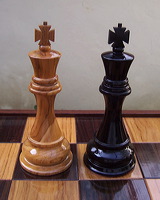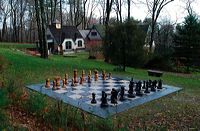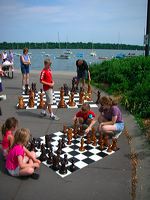Of all the games that have been created by the ingenuity of man, none is more challenging to the mind, nor more aesthetically pleasing to the soul than Chess. That Chess began as a game of war played by the royalty of only a few countries (SEE “Game of Chess”) does not detract from this, nor the fact that Chess today is played in every country, in every part of the world, by individuals of every rank and age, men and women, boys and girls, on sets pragmatically simple and others that would qualify as works of art, and some, even like the beautiful teak set and board at the left (created by GiantChess.com) that represent both.
 In fact, it is this combination of simplicity and beauty, mental challenge and aestheticism, that has resulted in chess being more popular today than ever, played by literally millions around the world.
In fact, it is this combination of simplicity and beauty, mental challenge and aestheticism, that has resulted in chess being more popular today than ever, played by literally millions around the world.
That Chess is easy to learn, yet difficult to master, only adds to its appeal; especially for children who are then rewarded not only with the joy of discovery at play, but the kind of challenge that helps to develop both mind and discipline in study. The fact that Chess can be played anywhere and any time, with very little equipment, also adds to its appeal.
And for those who still think of chess as a game of war instead of a battle of wits, it is an inescapable fact that aggression is part of life, and the stratagems that one has to learn in playing chess, as child or adult, can only serve as preparation for this. Even so, if it is also true that athletics, as practiced in ancient Athens and ancient Sparta, is the best preparation for war, then intellectual games such as chess may serve even better those who will one day embark on intellectual pursuits, which the world also needs.
Because strategy, however, is relevant to both game and sport, chess is often called an intellectual sport. The game is started with 16 chess pieces for each of the two players (See also “Game of Chess”), which are arranged on the two back rows on opposite sides of the chessboard, standing face to face as two armies ready to do battle. In the front row of the two armies, one traditionally white, the other traditionally black, are the eight Pawns (originally representing infantry soldiers), followed in the back row for each side, from each end to the middle, two Rooks, two Knights, two Bishops, one Queen (on her own color) and one King. The Chessboard itself consists of 64 black and white squares in alternation, with each player having one white square at his or her far right by international standard.
 To make a move, players must know the direction of each chess piece (SEE also the next section). The Pawn moves straight ahead one square at a time (except on its first move it can move either one or two squares; or when it takes an opponent’s piece, which it accomplishes by moving one square forward diagonally). The Rook can go straight, horizontally or vertically, provided there are no other pieces in the way. The movement of the Knight, the most difficult for the child to learn, is in the shape of the letter L. The movement of the Bishop is diagonal, with each bishop moving on squares of its own color. The most powerful and dangerous chess piece is not the King, as might be expected, but the Queen. The Queen can move freely in any direction either to defend, attack, or capture an opponent’s piece. The King, like the pawn, can only move one square at a time, but in any direction (provided it is not threatened there by an opponent’s piece, which is called “check”). The first move of the game is made by the player with the white pieces, followed by the player with the black pieces, continuing in alternation, each player trying, over the course of the game, to capture the other player’s king, and call “checkmate.”
To make a move, players must know the direction of each chess piece (SEE also the next section). The Pawn moves straight ahead one square at a time (except on its first move it can move either one or two squares; or when it takes an opponent’s piece, which it accomplishes by moving one square forward diagonally). The Rook can go straight, horizontally or vertically, provided there are no other pieces in the way. The movement of the Knight, the most difficult for the child to learn, is in the shape of the letter L. The movement of the Bishop is diagonal, with each bishop moving on squares of its own color. The most powerful and dangerous chess piece is not the King, as might be expected, but the Queen. The Queen can move freely in any direction either to defend, attack, or capture an opponent’s piece. The King, like the pawn, can only move one square at a time, but in any direction (provided it is not threatened there by an opponent’s piece, which is called “check”). The first move of the game is made by the player with the white pieces, followed by the player with the black pieces, continuing in alternation, each player trying, over the course of the game, to capture the other player’s king, and call “checkmate.”
 Of the many important things to consider in chess, therefore, the first and foremost is the security and safety of one’s own King. Another important thing to consider is the position of all of one’s pieces relative to the position of one’s opponent’s pieces, as if in a real battle. It is, therefore, very important to place one’s chess pieces in good squares to both attack and defend. The third most important thing to consider is control over the board, because the larger space that one controls, the more limited are the options of one’s opponent.
Of the many important things to consider in chess, therefore, the first and foremost is the security and safety of one’s own King. Another important thing to consider is the position of all of one’s pieces relative to the position of one’s opponent’s pieces, as if in a real battle. It is, therefore, very important to place one’s chess pieces in good squares to both attack and defend. The third most important thing to consider is control over the board, because the larger space that one controls, the more limited are the options of one’s opponent.
Not all games end in checkmate (when the king is in check, and so threatened with capture, but can’t move) some end in a tie (or draw; SEE Game Of Chess) as when a player can’t move any of his pieces, and his king is not in check; this is called stalemate.
